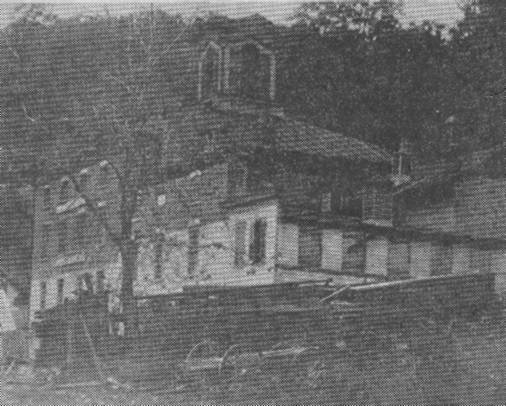![]()
McGregor Brewery

Built in 1845, the McGregor Brewery was located between McGregor
and North McGregor (now Marquette).
Huge caves were dug into the hill behind the structure for
storing beer kegs.
BREWERY ONCE A McGREGOR LANDMARK
by John R. AdneyMcGregor -- Long ago, the tall brick chimney that towered above the McGregor Brewery belched black smoke, and steam-powered malt mills converted homegrown barley into golden beer.
A landmark of early-day industry in the area, the four-story stone and brick structure, with its ornate cupola, was built by John L. Hagensick in 1845 at a cost of $25,000.
Nestling against rugged sandstone bluffs, just a mile north of town, the brewery employed ten people at peak periods and turned out 10,000 barrels of frothy suds a year.
Four huge caves, in which kegs of beer were stored on wooden racks, were dug 60 feet into the bluffs behind the brewery. The digging was done the hard way -- with pick and shovel and black blasting powder. Then, the roofs and walls of each cave were lined with limestone, quarried south of town.
Hagensick's beer business boomed from the start. For more than 40 years his beer was guzzled in every saloon for miles around.
The brewery became a social center in the early days. The beer garden and bowling alley that mushroomed up on the shady hillside did a lively business.
Then, the boom was busted. Production fell to 4,000 barrels in 1880.
Larger and more efficient breweries, making Milwaukee and Chicago the beer-brewing centers, were an important factor in the decline of the McGregor Brewery.
In an impressive ceremony in the fall of 1888, Hagensick, with his employees gathered around him, drove the bung in the last keg of beer that was loaded on the horse-drawn dlivery wagon.
Boiler fires were drawn and vats scrubbed for the last time. Surplus kegs were stacked in neat rows on the first floor. They were still there when the brewery was torn down in 1930.
The shuttered cupola, perched high above the sheet metal roof, was a pleasant place for sighseeing and day-dreaming for a boy with nothing else to do.-the photo & article were on a yellowed scrap of newspaper in my grandmother's scrapbook, it did not scan very clearly
-source: unknown, undated newspaper clipping
-contributed by S. Ferrall